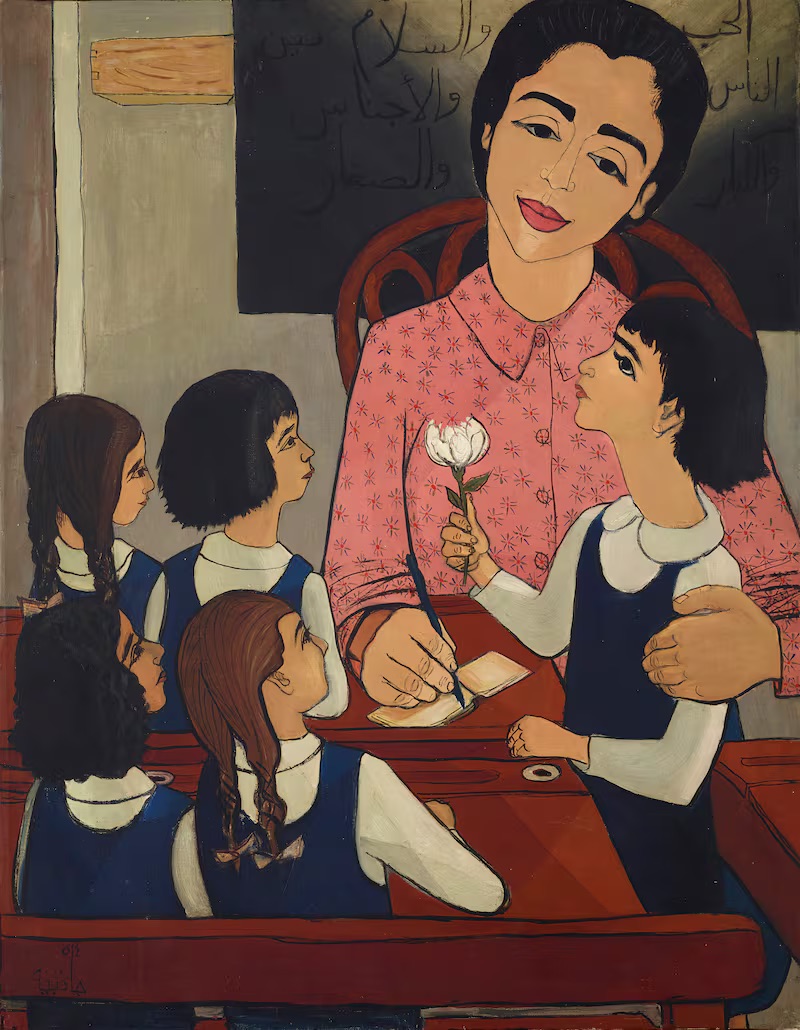Barjeel Art founder looks at the role of the educator in Arab society through a 1954 painting.
September is back-to-school month in the region. Children return to classrooms, routines and that perennial mix of trepidation and excitement. Today, the Emirates is ranked among the globe’s top education destinations, a remarkable feat given that formal schooling only took root in the early 1950s. Since the pandemic, classrooms have shifted again, with remote learning, artificial intelligence and mobile phones reshaping how children learn and interact.
Yet, school remains more than a place of instruction. It is a social crucible where identities are formed, friendships struck and where the memory of a good teacher can last a lifetime. Technology may enrich lessons, but it cannot replace those human connections.
It is precisely this bond that Gazbia Sirry captures in L’institutrice (1954). A group of young girls listen attentively to their teacher. One offers her a lotus flower, perhaps picked on the way to school, a gesture of thoughtfulness that precedes the lesson itself.
The lotus, Egypt’s national flower, becomes a symbol of unity and of the intimate ties between pupil and teacher. Behind them, the blackboard carries Sirry’s message: “Love and peace between peoples and races, old and young”. Painted at a time of sweeping reforms in Egypt – when writer Taha Hussein’s campaign for free schooling opened classrooms to poorer families – the work is both tender and political.

The UAE, too, has had its own champions of education. Sheikha Fatima bint Mubarak, celebrated as the Mother of the Nation, has advocated for girls’ education and literacy for over half a century. Pioneers such as Amna Al Hajeri and Nama bint Majid, honoured in 2014 as the UAE’s first formal teachers, began their work in the 1960s.
Today, Sheikha Bodour Al Qasimi, chairperson and president of the American University of Sharjah, inspires young Emiratis through her leadership in education and literacy. In 2015, the UAE launched the Global Teacher Prize, worth $1 million, to recognise outstanding educators worldwide. Its 2016 laureate, Palestinian teacher Hanan Al Hroub, devised her We Play and Learn approach after her own children were traumatised by witnessing a shooting on their way home from school. Her playful, trust-building methods are now celebrated internationally.
But admiring this painting is also an opportunity to remember that across the Arab world, millions of children remain outside the classroom. Sudan’s civil war, raging since 2023, has left 17 million students without schooling. It is a tragic irony, given the role Sudanese professionals once played in building the Emirates – figures such as Kamal Hamza, Dubai Municipality’s director from 1961 to 1985. In Syria, 2.4 million children were displaced from classrooms after 2011; with the war’s end in 2024, there is cautious hope they may return.
The most devastating case is Gaza, where what Lebanese academic Gilbert Achcar has called the karitha (the catastrophe), which, according to the UN, killed or injured 50,000 Palestinian children and left 645,000 more out of school, with no prospect of resuming their education.
As our own children head back to their lessons, we must remember those denied this fundamental chance. The words on Sirry’s blackboard – “Love and peace between peoples and races” – feel painfully distant. Yet, for the sake of all children across the Arab world, we must keep them alive, as both hope and imperative.
This article was originally published in The National on September 11, 2025. A PDF screenshot of the article can be downloaded here.